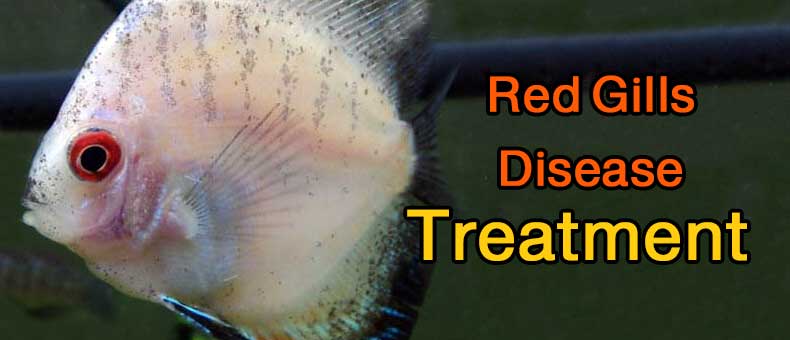
Red Gills Disease
Red gills are a condition that affects Discus fishes much like other kinds of ornamental fishes. It could be a result of a bacteria known as Gram-negative columnaris, an attack by a protozoan, or other causes.
Table of Contents
- Red Gills Disease
- Symptoms Associated With Discus Red Gills
- Disease Description & Causes (Red Gills In Discus)
- How Can Discus Red Gills Be Treated?
- Red Gills Future Prevention Tips
- Conclusion
Symptoms Associated With Discus Red Gills
The symptoms of Gram-negative columnaris or simply columnaris in Discus are highlighted below
- Frayed and ragged fins.
- Ulcerations on the skin.
- Red spots at the base of the pectoral fins.
- Loss of the epidermis (outer skin).
- White and cloudy patches that look like fungus. They are especially found on the filaments of the gills.
- Mucus on the head, dorsal regions, and the head.
- The color of the gills begins to change to either light brown, dark brown, or red.
- Laborious and rapid breathing.
- No desire to eat (appetite loss).
Disease Description & Causes (Red Gills In Discus)
What causes red gills in Discus fish? Columnaris is Gram-negative bacteria that brings disease to the gills of Discus. The bacteria basically attack the gills and once discus fishes have been infected by these bacteria, their gills either turn brown or red and they become swollen.
Other symptoms or conditions that accompany the inflamed and discolored gills include red spots which can be found at the bottom area of the pectoral fins. With proper observation, one may find that due to the build-up of mucus, areas around the gill plate will begin to look like thin paper.
Red Gills Disease Causes
[1] – If Discus is extremely uncomfortable (highly stressed) in the tank, the risk of it having columnaris increases.
You could learn more about all reasons behind Discus stress and how to treat it:
[2] – Columnaris is bacteria that can be found in unhealthy water, therefore, if the water condition in the tank is very poor or unstable, it is easy for the bacteria to develop.
[3] – When columnaris enters the tank water, it can stay active in that water for about 32 days if the water hardness is either 50 ppm or more than that.
[4] – Columnaris invades a tank water is if the water pH is always fluctuating (not stable).
[5] – If Discus is provided with an inadequate diet, the risk of the fish being affected by columnaris increases by a great deal. Also,
[6] – Fighting and/or nipping discus happens to be injured, it will be easy for the bacteria to invade and attack the gills of the fish.
How Can Discus Red Gills Be Treated?
Discus red gills disease can be treated using the below steps:
Treatment Steps & Methods For Discus Red Gills
[Method 1] – Using Salt Bath
- Use salt: Columnaris is a disease that cannot survive in salt solutions of more than 1 percent. Pour salt into the tank water.
- Carry out treatment baths: Conduct a treatment bath for each one of your discus fishes that are already infected. If the case is so severe that most of the fishes are infected, then you must treat your entire aquarium.
- Use antibiotics: Get antibiotics that can be used to treat diseases caused by Gram-negative bacteria. A good example of an antibiotic to use is Oxytetracycline. NOTE: On some occasions, the antibiotics kill the bacteria that is beneficial to ]iscus, and some other times, they do not.
- Keep water clean: Make sure that the tank water is clean and perform a 30 to 50 percent water change.
Learn how to make a healthy Discus environments:
[Method 2] – Using Medicated Food
The following is how you can treat red gills in discus using medicated food:
- Heat 1/4 cup (2 oz. or 58 ml) of water in a microwave.
- Next, blend plain gelatin derived from animals – particularly Knox gelatin (11/4 ounces) into the water being heated in the microwave and stir the mixture vigorously.
- Then, take 2 tbsps. of flakes or pellets and pour into a bowl after which you add some of the mixtures of gelatin and water and then stir till you get a paste. NOTE: If the entire mixture is too watery, add more pellets or flakes.
- Next, add about 1/16 tsp. of the medicine to the mud and then thoroughly mix everything. Spread the mixture like a pancake of about 3 mm thickness on a plate or plastic film and then place it in the refrigerator.NOTE: If you want to have it for more than a fortnight, freeze it after placing it in a plastic bag.
- This treatment process needs to be performed for two weeks at least. Even if the red gills can only be found on a single discus fish, the entire aquarium should be treated. Columnaris is a disease that kills rapidly, therefore all the fishes that have been exposed should be treated.
- Treat the water: Before performing water treatment, remove the biofiltration media including either sponge or foam in the filters, and keep it in an open container while the water is being treated. The nature of the antibiotics being used in the water will be changed if the filters are not removed.
- Monitor the ammonia levels: In the tank water and do a 50 percent water change if the level goes beyond 1 ppm.
- Reduce the amount of food fed to discuss by 2/3 rds.
Red Gills Future Prevention Tips
If you want to prevent red gills in discus fishes do the following:
- Remove dead fishes in the tank in order to avoid the spread of the disease. This is to prevent the fishes that survive from pecking on the fish that has been infected.
- Feed the proper diet to Your Discus
- Quarantine new equipment or fishes you want to add to the tank for about 3 wks. before you add them to the tank to make sure that proper hygiene is maintained.
- Maintain a good quality of tank water.
- Avoid overcrowding in the tank.
Conclusion
Red gill disease is very deadly. They can kill discus and every other fish in the tank once they become infected. It is best to keep your tank and tank water clean to avoid contamination rather than trying to treat the fishes when they become infected.


